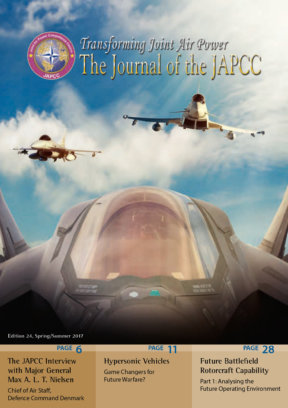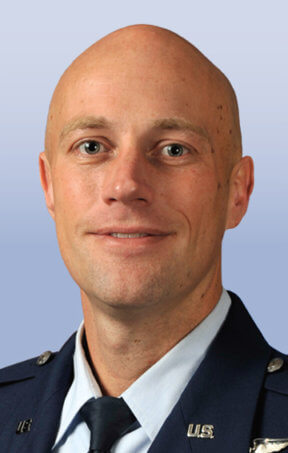Introduction
On a cold, clear night in Afghanistan in November 2011, an Air Force AC-130 Gunship and an AH-64 Apache check in with the Army ground party they are to work with. Both aircraft are providing close air support (CAS) utilizing the latest in sensor technology and accurate weaponry. The ground parties are glad to hear from the crew. They are intimately familiar with the capabilities they bring, having counted on the Air Force for support with previous missions. The aircrew provides the Joint Terminal Attack Controller (JTAC) with their mission number, call sign, altitude, ordnance, estimated time on target and station time, available sensors and air-to air refuelling control time. On this night, the Air Force AC-130 Gunship and AH-64 Apache provide CAS for a direct-action mission to capture a high value individual (HVI). The mission consists of a safe infiltration for the friendly ground forces by helicopter airlift, fire support and sensor coordination between all air and ground assets, and capture of the HVI. The safe exfiltration of the ground forces to their Forward Operating Base (FOB) culminates a successful mission.
The natural professionalism and confidence of each military asset begs one to wonder, was is it always this way? Unfortunately, no. The history of CAS within the US military is one of sometimes bitter inter-service rivalry, but the lessons learned benefit US and NATO forces in the field today, as this article will illustrate. Within the remainder if this essay, the use of the terms ‘Army’ and ‘Air Force’ will always refer to the US military unless stated otherwise.
Primacy of CAS – The Struggle for Roles and Mission
When the US Air Force became a separate branch of the military in 1947, it anticipated taking all or most of the air functions from the US Army.1 The Key West agreement of 1948 further identified the service roles and missions of the Air Force.2 The Army and Air Force would agree to cooperate as a team on joint missions and the Air Force would provide the Army with airlift and CAS. The CAS matter in particular would lead to tension between the Army and Air Force, in regards to who would perform the role and how it would be performed. The Army was unhappy with the CAS provided by the Air Force during the Korean War (1950–1954) and did not agree with the centralized command and control concept the Air Force wanted. The Army desired to create its own air force, and the 1950s saw an increase of Army aviation comprised of 668 light airplanes, 57 helicopters, and the birth of the airmobile concept.3
From 1948 until 1956, multiple directives and agreements were published to address the scope, roles, and mission sets for both the US Air Force and Army. However, these memorandums did not address the concerns and disagreements. In 1957, Secretary of Defense Charles E. Wilson issued Directive 5160.22, which stated the Army would not provide aircraft to perform the following functions: 1) strategic and tactical airlift, 2) tactical reconnaissance, 3) interdiction of the battlefield, 4) CAS. More importantly, the Air Force was to meet reasonable requirements as specified by the Army and use appropriate resources.4 This statement led to further tension, since the Air Force believed the use of CAS by the Army was redundant and overlapped in effort and execution.5 In particular, the Air Force did not approve the use of helicopter gunships for CAS by the Army and preferred to control them as well.6
In the 1960s, both services put pressure on US Secretary of Defense Robert S. McNamara to provide for a military force structure with clearly defined roles to meet operational requirements.7 Unfortunately, the directives he issued to resolve the dispute of roles and missions did not address the Army’s concerns regarding better CAS provided by the Air Force, nor did it address the Air Force’s concerns about the Army’s ever increasing expansion in aviation. Secretary McNamara preferred to let the Chiefs of Staff from the Army and Air Force develop the requirements of each service and send them forward for consideration.8
The Vietnam War would see the emergence of airmobile operations by the Army with helicopters equipped to provide CAS with an agile, small footprint and the Air Force’s insertion of Special Air Warfare with the use of light attack aircraft such as the A-1, A-26 and A-37. President John F. Kennedy’s ‘Flexible Response’ strategy and message to each service was clear: develop special force capabilities in unconventional warfare to counter enemy forces. However, compliance with this political guidance was hampered by both the Army and Air Force’s persistent habit of fighting in a more conventional manner. The Army was still trained and equipped for the conventional warfare that was successful in World War II, and continued to prefer fighting guerrilla forces with the concept of attrition. The Air Force favoured conventional bombing of North Vietnam with little emphasis placed on countering insurgency in South Vietnam.9
Inter-Service Disagreements on CAS
The US Army and Air Force differences concerning CAS originated from World War II and continued into Vietnam. For the Army, the concerns about the Air Force providing CAS centred on the types of aircraft employed and the responsiveness of the Air Force. But this was not the only differing issue; command and control continued to be a focal point of opposing opinions.
The Air Force envisioned a multi-role fighter and attack aircraft capable of speeds that could avoid surface-to-air threats and a weapon payload flexible enough to perform multiple roles.10 The Army, however, desired an aircraft with adequate loiter time to support ground forces from a lower altitude and with better bombing accuracy; speed was not a priority.11 The other outstanding criticism was the slow response time for immediate fire support requests from ground forces. Because of the limited number of available CAS assets, in particular the AC-47, the response was sometimes as much as 90 minutes.12 The use of army helicopter gunships helped to reduce the gap, along with staging forces on alert to provide CAS as required. However, while the Air Force claimed success in CAS operations, the Army viewed the close air fire support of UH-1 helicopters as a mitigation of slow response times, not as a solution to the CAS issue.13
Differences in command and control also dated to World War II. The US Air Force viewed the success of the combined air and ground campaign in North Africa with the Royal Air Force (RAF) operating under centralized control as the desired application of air resources. The Army disagreed, believing CAS was neglected in favour of air interdiction and air superiority missions.14 The sample of centralized control was too small to indicate a clearly defined, successful way of controlling air assets. The Vietnam War would see the differences in command and control unresolved as the Army and Air Force pursued their own interests. The Air Force wanted all air power assets operating under the Tactical Air Control System (TACS), while the Army favoured the use of organic air power assets under the control of ground forces, which it felt provided quicker response time and support.15
Doctrine Development
With different views on CAS and command and control by the Army and Air Force in Vietnam, developing doctrine was imperative. The early doctrine development of CAS originated with the combat experiences of the Army and Air Force pioneers during World War II, the Korean War, and the Vietnam War.16 These conflicts cultivated tactics, techniques, and procedures (TTP) that would ultimately develop the framework for the doctrinal guidance in use today. For example, some of the same TTP gained from aircrew flying the first gunship, the AC-47 in Vietnam, are still practiced today when conducting CAS in the AC-130U/W.
Developed out of the successes and failures of the past, the US Joint Publication 3-09.3 on CAS clearly defines CAS as the air action by fixed and rotary wing aircraft against hostile targets which are in close proximity to friendly forces and which require detailed integration of each air mission with the fire and movement of those forces.17 In particular, this doctrine excludes a centralized air command and control concept regarding CAS that was already ill-suited for the needs of the Army in Vietnam.
Lessons Learned
The rise of CAS and air power benefitted from the Army and Air Force inter-service rivalry, which peaked during the Vietnam War. Competing differences in aircraft, command and control, and clear, defined mission roles proved troublesome during the Korean and Vietnam Wars. The Air Force and Army worked through each services’ requirements and goals to clearly define CAS doctrine and employ both fixed and rotary wing CAS effectively and efficiently in combat. Today, the US military and NATO partners have enhanced the effectiveness of CAS and joint force application with officers attending joint military educational institutions and participating in joint force exercises. A key lesson learned from the Vietnam War regarding CAS was the need to reduce the time required to get support to ground forces in contact with the enemy.
The battlefield today contains multiple air players providing redundancy and overlapping CAS competencies to better support ground forces. A typical combat mission for a crew of an AC-130 Gunship, a low-density, high-demand asset like the AC-47 was in Vietnam, could provide CAS for a US Army, British, or Canadian special forces ground unit or even a conventional ground unit involved in a troops in contact (TIC) situation. In the air stack today, one can expect to find an AC-130, an AH-64, a U-28, an RPA, an A-10 and possibly a B-1 or B-52 Bomber all being controlled by a JTAC.18 What is important to emphasize in the history of the inter-service rivalry between the Army and Air Force is that the different perspectives that existed between both branches of the military each had merit, and the more each service worked with the other, the more CAS improved.
The importance of joint air operations has never been more understood than it is now. Advancing technology in RPAs performing ISR and CAS roles has permitted an increased CAS extension around the globe. While command and control can always be improved, it is clear that CAS will continue to evolve for the better, supporting ground forces with on call, quick, precision fire support on the battlefield.












